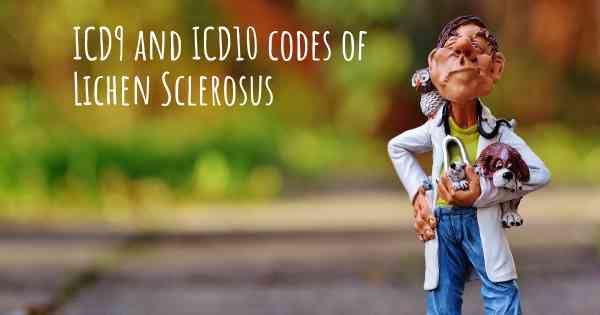16
ICD10 code of Lichen Sclerosus and ICD9 code
What is the ICD10 code for Lichen Sclerosus? And the ICD9 code for Lichen Sclerosus?

The ICD10 code for Lichen Sclerosus is L90.0. In the ICD9 coding system, it is represented by 701.0. Lichen Sclerosus is a chronic inflammatory skin condition that primarily affects the genital and anal areas. It is characterized by white, patchy skin that can cause itching, pain, and discomfort. Proper diagnosis and treatment are essential to manage this condition effectively.
Lichen sclerosus is a chronic inflammatory skin condition that primarily affects the genital and anal areas, although it can also occur in other parts of the body. It is characterized by the formation of white, patchy, and thin skin that can cause itching, pain, and discomfort. The condition mainly affects women, although men and children can also be affected.
In terms of medical coding, the International Classification of Diseases, 10th Revision (ICD-10) provides specific codes for lichen sclerosus. The ICD-10 code for lichen sclerosus is L90.0. This code falls under the category of "Other disorders of the epidermis," which includes various skin conditions.
On the other hand, the previous version of the classification system, the International Classification of Diseases, 9th Revision (ICD-9), had a different code for lichen sclerosus. The ICD-9 code for lichen sclerosus was 701.8. This code fell under the category of "Other specified diseases of skin and subcutaneous tissue." However, it is important to note that the ICD-9 system is no longer in use as it has been replaced by the more comprehensive ICD-10 system.
These codes are used by healthcare professionals for accurate documentation, billing, and statistical purposes. By assigning the appropriate ICD-10 code for lichen sclerosus, healthcare providers can communicate effectively with other professionals, insurance companies, and health agencies, ensuring proper management and monitoring of the condition.
In conclusion, the ICD-10 code for lichen sclerosus is L90.0, while the ICD-9 code, which is no longer in use, was 701.8. These codes play a crucial role in accurately identifying and classifying the condition for effective healthcare management.
In terms of medical coding, the International Classification of Diseases, 10th Revision (ICD-10) provides specific codes for lichen sclerosus. The ICD-10 code for lichen sclerosus is L90.0. This code falls under the category of "Other disorders of the epidermis," which includes various skin conditions.
On the other hand, the previous version of the classification system, the International Classification of Diseases, 9th Revision (ICD-9), had a different code for lichen sclerosus. The ICD-9 code for lichen sclerosus was 701.8. This code fell under the category of "Other specified diseases of skin and subcutaneous tissue." However, it is important to note that the ICD-9 system is no longer in use as it has been replaced by the more comprehensive ICD-10 system.
These codes are used by healthcare professionals for accurate documentation, billing, and statistical purposes. By assigning the appropriate ICD-10 code for lichen sclerosus, healthcare providers can communicate effectively with other professionals, insurance companies, and health agencies, ensuring proper management and monitoring of the condition.
In conclusion, the ICD-10 code for lichen sclerosus is L90.0, while the ICD-9 code, which is no longer in use, was 701.8. These codes play a crucial role in accurately identifying and classifying the condition for effective healthcare management.
Diseasemaps
The ICD10 code for Lichen Sclerosus is L90.0.
Posted Oct 8, 2017 by Cindy 3050
I've googled it but I don't think this is relevant in New Zealand. Basic lichen sclerosis care is treated under our health care system and many have private insurance. I'm not aware of procedures like PLP and Mona Lisa being done in NZ but I really don't know as I haven't investigated it.
Posted Oct 9, 2017 by annie-mcg 2000
697.9 and also L90.0 are the codes
Posted Aug 25, 2018 by Tbreck 2500
L90.0 is a billable code for LS
Posted Oct 11, 2018 by Allicia 2500
Preparing for the ICD-10 Code Set: Fact Sheet 2 October 1, 2014 Compliance Date Get the Facts
to be Compliant
The Differences Between ICD-9 and ICD-10
This is the second fact sheet in a series and is focused on the differences between the ICD-9 and ICD-10 code sets. Collectively, the fact sheets will provide information, guidance, and checklists to assist you with understanding what you need to do to implement the ICD-10 code set.
The ICD-10 code sets are not a simple update of the ICD-9 code set. The ICD-10 code sets have fundamental changes in structure and concepts that make them very different from ICD-9. Because of these differences, it is important to develop a preliminary understanding of the changes from ICD-9 to ICD-10. This basic understanding of the differences will then identify more detailed training that will be needed to appropriately use the ICD-10 code sets. In addition, seeing the differences between the code sets will raise awareness of the complexities of converting to the ICD-10 codes.
Overall Comparisons of ICD-9 to ICD-10
Issues today with the ICD-9 diagnosis and procedure code sets are addressed in ICD-10. One concern today with ICD-9 is the lack of specificity of the information conveyed in the codes. For example, if a patient is seen for treatment of a burn on the right arm, the ICD-9 diagnosis code does not distinguish that the burn is on the right arm. If the patient is seen a few weeks later for another burn on the left arm, the same ICD-9 diagnosis code would be reported. Additional documentation would likely be required for a claim for the treatment to explain that the burn treated at this time is a different burn from the one that was treated previously. In the ICD-10 diagnosis code set, characters in the code identify right versus left, initial encounter versus subsequent encounter, and other clinical information.
Another issue with ICD-9 is that some chapters are full and impede the ability to add new codes. In some cases, new codes have been assigned to different chapters making it difficult to locate all available codes. ICD-10 codes have increased character length, which greatly expands the number of codes that are available for use. With more available codes, it is less likely that chapters will run out of codes in the future.
Other issues that are addressed in ICD-10 include the use of full code titles and appropriately reflecting advances in medical knowledge and technology. More detailed information and examples are provided below to demonstrate the differences between the ICD-9 and ICD-10 code sets.
Diagnosis Codes
The following table provides a comparison of the features of the ICD-9 and ICD-10 diagnosis code sets.
Table 1 – Comparisons of the Diagnosis Code Sets
Copyright 2012 American Medical Association All Rights Reserved. Last Updated September 25, 2012
Alert: The new ICD-10 compliance date is October 1, 2014.
ICD-9
ICD-10
3-5 characters in length
3-7 characters in length
Approximately 13,000 codes
Approximately 68,000 available codes
First digit may be alpha (E or V) or numeric; digits 2-5 are numeric
Digit 1 is alpha; digits 2 and 3 are numeric; digits 4-7 are alpha or numeric
Preparing for the ICD-10 Code Set: Fact Sheet 2 October 1, 2014 Compliance Date Get the Facts
to be Compliant
In the ICD-10 diagnosis code set, the alpha characters are not case sensitive. The following examples show a comparison of the formats of the ICD-9 and ICD-10 diagnosis codes. You can see the use of alpha characters and longer codes in ICD-10.
The expanded number of characters of the ICD-10 diagnosis codes provides greater specificity to identify disease etiology, anatomic site, and severity.
ICD-10 Code Structure:
Characters 1-3 – Category
Characters 4-6 – Etiology, anatomic site, severity, or other clinical detail Characters 7 – Extension
The following example shows the more detailed information gained through the added characters.
S52 Fracture of forearm
S52.5 Fracture of lower end of radius
S52.52 Torus fracture of lower end of radius S52.521 Torus fracture of lower end of right radius
S52.521A Torus fracture of lower end of right radius, initial encounter for closed fracture
In the above example, S52 is the category. The fourth and fifth characters of “5” and “2” provide additional clinical detail and anatomic site. The sixth character in this example indicates laterality, i.e., right radius. The seventh character, “A”, is an extension that provides additional information, which means “initial encounter” in this example.
The example of the forearm fracture also demonstrates the use of the full code titles, which was not the format in the ICD-9 diagnosis code set. The following is a comparison of ICD-9 and ICD-10 diagnoses demonstrating the use of full code titles.
Limited space for adding new codes
Flexible for adding new codes
Lacks detail
Very specific
Lacks laterality
Has laterality (i.e., codes identifying right vs. left)
ICD-9 Diagnosis Code
382.9 Acute otitis media 540.9 Acute appendicitis 780.01 Coma
ICD-10 Diagnosis Code
B01.2 Varicella pneumonia
K21.0 Gastro-esophageal reflux disease with esophagitis O30.003 Twin pregnancy, unspecified, third trimester
ICD-9 Diagnosis Codes
157 Malignant neoplasm of pancreas 157.0 Head of pancreas
157.1 Body of pancreas
157.2 Tail of pancreas
157.3 Pancreatic duct
157.4 Islets of Langerhans
157.8 Other specified sites of pancreas 157.9 Pancreas, part unspecified
ICD-10 Diagnosis Codes
S52 Fracture of forearm
S52.5 Fracture of lower end of radius
S52.5 Fracture of lower end of radius
S52.521 Torus fracture of lower end of right radius S52.521A Torus fracture of lower end of right radius, initial encounter for closed fracture
The ICD-10 diagnosis code set also expands on the use of combination codes. Combination codes are a single code that can be used to classify 1) two diagnoses, or 2) a diagnosis with an associated secondary
Copyright 2012 American Medical Association All Rights Reserved. Last Updated September 25, 2012
Preparing for the ICD-10 Code Set: Fact Sheet 2 October 1, 2014 Compliance Date Get the Facts
to be Compliant
process or a diagnosis with an associated complication. Combination codes allow for the reporting of a single code to express multiple elements of the diagnosis. The following are examples illustrating combination codes in ICD-10 versus ICD-9 diagnosis codes.
The increased specificity of the ICD-10 codes is more flexible, which means that emerging diseases can be quickly incorporated. The higher level of detail in the codes provides the ability to more precisely code the diagnosis. As with ICD-9, ICD-10 codes are to be reported at the highest level of detail possible within the code structure. ICD-10 reflects advances in medicine and medical technology making the code set more relevant to today’s understanding of diagnoses. ICD-10 also provides an improved ability to measure health care services and conduct public health surveillance.
Procedure Codes
ICD-10-PCS will not replace the Current Procedural Terminology (CPT®) and Healthcare Common Procedure Coding System (HCPCS) code sets for reporting services and procedures in outpatient and office settings.
The following table is a comparison of the differences in the features between the ICD-9 and ICD-10 procedure code sets.
Table 2 – Comparisons of Procedure Codes
ICD-9 Diagnosis Codes
ICD-10 Diagnosis Codes
415.0 Acute cor pulmonale
And
415.12 Septic pulmonary embolism
I26.01 Septic pulmonary embolism with acute cor pulmonale
707.06 Pressure ulcer, ankle And
707.21 Pressure ulcer stage I
L89.501 Pressure ulcer of unspecified ankle, stage I
ICD-9
ICD-10
3-4 numbers in length
7 alpha-numeric characters in length
Approximately 3,000 codes
Approximately 87,000 available codes
Based on outdated technology
Reflects current usage of medical terminology and devices
Limited space for adding new codes
Flexible for adding new codes
Lacks detail
Very specific
Lacks laterality
Has laterality
Generic terms for body parts
Detailed descriptions for body parts
Lacks descriptions of methodology and approach for procedures
Provides detailed descriptions of methodology and approach for procedures
Lacks precision to adequately define procedures
Precisely defines procedures with detail regarding body part, approach, any device used, and qualifying information
® CPT is a registered trademark of the American Medical Association
Copyright 2012 American Medical Association All Rights Reserved. Last Updated September 25, 2012
Preparing for the ICD-10 Code Set: Fact Sheet 2 October 1, 2014 Compliance Date Get the Facts
to be Compliant
The following are examples showing the different formats of the procedure codes.
The alpha characters in the ICD-10 procedure code set are not case sensitive. The letters O and I are not used to avoid confusion with the numbers 0 and 1.
The additional characters in the ICD-10 procedure code set allows for identifying the body system, root operation, body part, approach, and device involved in the procedure. The code structure in the Medical and Surgical section is:
The following example identifies the meaning of each character of the code.
Right knee joint replacement = 0SRD0JZ 0 = Medical and Surgical Section S = Lower Joints
R = Replacement
D = Knee Joint, Right
0 = Open
J = Synthetic Substitute Z = No Qualifier
As with the ICD-10 diagnosis code set, there are many benefits to the ICD-10 procedure code set. It provides greater detail to describe complex medical procedures and describes precisely what was done to the patient. There is plenty of space to add new procedures. It uses current medical terminology. The codes follow a logical structure. There is standardized terminology, which means that each term has the exact same meaning across the code set. The codes also have a multi-axial structure, meaning that each code character has the same meaning within procedure sections and across the code set where possible.
Conclusion
The ICD-10 code sets are not simply increased and renumbered ICD-9 code sets. The move to ICD-10 will not be easy. The ICD-10 code sets include greater detail, changes in terminology, and expanded concepts for injuries, laterality, and other related factors. The complexity of ICD-10 provides many benefits because of the increased level of detail conveyed in the codes. The complexity also underscores the need to be adequately trained on ICD-10 in order to fully understand reporting changes that will come with the new code sets.
Copyright 2012 American Medical Association All Rights Reserved. Last Updated September 25, 2012
ICD-9 Procedure Code
39.50 Angioplasty 39.31 Suture of artery 47.01 Laparoscopic appendectomy
ICD-10 Diagnosis Code
0DN90ZZ 0FB03ZX 02PS0CZ right, open
Release of duodenum, open approach
Excision of liver, percutaneous approach, diagnostic
Removal, extraluminal device from pulmonary vein,
Character
1
2
3
4
5
6
7
Definition
Name of Section
Body System
Root Operation
Body Part
Approach
Device
Qualifier
Visit the AMA’s website for more resources for implementing the ICD-10 code set.
www.ama-assn.org/go/ICD-10
to be Compliant
The Differences Between ICD-9 and ICD-10
This is the second fact sheet in a series and is focused on the differences between the ICD-9 and ICD-10 code sets. Collectively, the fact sheets will provide information, guidance, and checklists to assist you with understanding what you need to do to implement the ICD-10 code set.
The ICD-10 code sets are not a simple update of the ICD-9 code set. The ICD-10 code sets have fundamental changes in structure and concepts that make them very different from ICD-9. Because of these differences, it is important to develop a preliminary understanding of the changes from ICD-9 to ICD-10. This basic understanding of the differences will then identify more detailed training that will be needed to appropriately use the ICD-10 code sets. In addition, seeing the differences between the code sets will raise awareness of the complexities of converting to the ICD-10 codes.
Overall Comparisons of ICD-9 to ICD-10
Issues today with the ICD-9 diagnosis and procedure code sets are addressed in ICD-10. One concern today with ICD-9 is the lack of specificity of the information conveyed in the codes. For example, if a patient is seen for treatment of a burn on the right arm, the ICD-9 diagnosis code does not distinguish that the burn is on the right arm. If the patient is seen a few weeks later for another burn on the left arm, the same ICD-9 diagnosis code would be reported. Additional documentation would likely be required for a claim for the treatment to explain that the burn treated at this time is a different burn from the one that was treated previously. In the ICD-10 diagnosis code set, characters in the code identify right versus left, initial encounter versus subsequent encounter, and other clinical information.
Another issue with ICD-9 is that some chapters are full and impede the ability to add new codes. In some cases, new codes have been assigned to different chapters making it difficult to locate all available codes. ICD-10 codes have increased character length, which greatly expands the number of codes that are available for use. With more available codes, it is less likely that chapters will run out of codes in the future.
Other issues that are addressed in ICD-10 include the use of full code titles and appropriately reflecting advances in medical knowledge and technology. More detailed information and examples are provided below to demonstrate the differences between the ICD-9 and ICD-10 code sets.
Diagnosis Codes
The following table provides a comparison of the features of the ICD-9 and ICD-10 diagnosis code sets.
Table 1 – Comparisons of the Diagnosis Code Sets
Copyright 2012 American Medical Association All Rights Reserved. Last Updated September 25, 2012
Alert: The new ICD-10 compliance date is October 1, 2014.
ICD-9
ICD-10
3-5 characters in length
3-7 characters in length
Approximately 13,000 codes
Approximately 68,000 available codes
First digit may be alpha (E or V) or numeric; digits 2-5 are numeric
Digit 1 is alpha; digits 2 and 3 are numeric; digits 4-7 are alpha or numeric
Preparing for the ICD-10 Code Set: Fact Sheet 2 October 1, 2014 Compliance Date Get the Facts
to be Compliant
In the ICD-10 diagnosis code set, the alpha characters are not case sensitive. The following examples show a comparison of the formats of the ICD-9 and ICD-10 diagnosis codes. You can see the use of alpha characters and longer codes in ICD-10.
The expanded number of characters of the ICD-10 diagnosis codes provides greater specificity to identify disease etiology, anatomic site, and severity.
ICD-10 Code Structure:
Characters 1-3 – Category
Characters 4-6 – Etiology, anatomic site, severity, or other clinical detail Characters 7 – Extension
The following example shows the more detailed information gained through the added characters.
S52 Fracture of forearm
S52.5 Fracture of lower end of radius
S52.52 Torus fracture of lower end of radius S52.521 Torus fracture of lower end of right radius
S52.521A Torus fracture of lower end of right radius, initial encounter for closed fracture
In the above example, S52 is the category. The fourth and fifth characters of “5” and “2” provide additional clinical detail and anatomic site. The sixth character in this example indicates laterality, i.e., right radius. The seventh character, “A”, is an extension that provides additional information, which means “initial encounter” in this example.
The example of the forearm fracture also demonstrates the use of the full code titles, which was not the format in the ICD-9 diagnosis code set. The following is a comparison of ICD-9 and ICD-10 diagnoses demonstrating the use of full code titles.
Limited space for adding new codes
Flexible for adding new codes
Lacks detail
Very specific
Lacks laterality
Has laterality (i.e., codes identifying right vs. left)
ICD-9 Diagnosis Code
382.9 Acute otitis media 540.9 Acute appendicitis 780.01 Coma
ICD-10 Diagnosis Code
B01.2 Varicella pneumonia
K21.0 Gastro-esophageal reflux disease with esophagitis O30.003 Twin pregnancy, unspecified, third trimester
ICD-9 Diagnosis Codes
157 Malignant neoplasm of pancreas 157.0 Head of pancreas
157.1 Body of pancreas
157.2 Tail of pancreas
157.3 Pancreatic duct
157.4 Islets of Langerhans
157.8 Other specified sites of pancreas 157.9 Pancreas, part unspecified
ICD-10 Diagnosis Codes
S52 Fracture of forearm
S52.5 Fracture of lower end of radius
S52.5 Fracture of lower end of radius
S52.521 Torus fracture of lower end of right radius S52.521A Torus fracture of lower end of right radius, initial encounter for closed fracture
The ICD-10 diagnosis code set also expands on the use of combination codes. Combination codes are a single code that can be used to classify 1) two diagnoses, or 2) a diagnosis with an associated secondary
Copyright 2012 American Medical Association All Rights Reserved. Last Updated September 25, 2012
Preparing for the ICD-10 Code Set: Fact Sheet 2 October 1, 2014 Compliance Date Get the Facts
to be Compliant
process or a diagnosis with an associated complication. Combination codes allow for the reporting of a single code to express multiple elements of the diagnosis. The following are examples illustrating combination codes in ICD-10 versus ICD-9 diagnosis codes.
The increased specificity of the ICD-10 codes is more flexible, which means that emerging diseases can be quickly incorporated. The higher level of detail in the codes provides the ability to more precisely code the diagnosis. As with ICD-9, ICD-10 codes are to be reported at the highest level of detail possible within the code structure. ICD-10 reflects advances in medicine and medical technology making the code set more relevant to today’s understanding of diagnoses. ICD-10 also provides an improved ability to measure health care services and conduct public health surveillance.
Procedure Codes
ICD-10-PCS will not replace the Current Procedural Terminology (CPT®) and Healthcare Common Procedure Coding System (HCPCS) code sets for reporting services and procedures in outpatient and office settings.
The following table is a comparison of the differences in the features between the ICD-9 and ICD-10 procedure code sets.
Table 2 – Comparisons of Procedure Codes
ICD-9 Diagnosis Codes
ICD-10 Diagnosis Codes
415.0 Acute cor pulmonale
And
415.12 Septic pulmonary embolism
I26.01 Septic pulmonary embolism with acute cor pulmonale
707.06 Pressure ulcer, ankle And
707.21 Pressure ulcer stage I
L89.501 Pressure ulcer of unspecified ankle, stage I
ICD-9
ICD-10
3-4 numbers in length
7 alpha-numeric characters in length
Approximately 3,000 codes
Approximately 87,000 available codes
Based on outdated technology
Reflects current usage of medical terminology and devices
Limited space for adding new codes
Flexible for adding new codes
Lacks detail
Very specific
Lacks laterality
Has laterality
Generic terms for body parts
Detailed descriptions for body parts
Lacks descriptions of methodology and approach for procedures
Provides detailed descriptions of methodology and approach for procedures
Lacks precision to adequately define procedures
Precisely defines procedures with detail regarding body part, approach, any device used, and qualifying information
® CPT is a registered trademark of the American Medical Association
Copyright 2012 American Medical Association All Rights Reserved. Last Updated September 25, 2012
Preparing for the ICD-10 Code Set: Fact Sheet 2 October 1, 2014 Compliance Date Get the Facts
to be Compliant
The following are examples showing the different formats of the procedure codes.
The alpha characters in the ICD-10 procedure code set are not case sensitive. The letters O and I are not used to avoid confusion with the numbers 0 and 1.
The additional characters in the ICD-10 procedure code set allows for identifying the body system, root operation, body part, approach, and device involved in the procedure. The code structure in the Medical and Surgical section is:
The following example identifies the meaning of each character of the code.
Right knee joint replacement = 0SRD0JZ 0 = Medical and Surgical Section S = Lower Joints
R = Replacement
D = Knee Joint, Right
0 = Open
J = Synthetic Substitute Z = No Qualifier
As with the ICD-10 diagnosis code set, there are many benefits to the ICD-10 procedure code set. It provides greater detail to describe complex medical procedures and describes precisely what was done to the patient. There is plenty of space to add new procedures. It uses current medical terminology. The codes follow a logical structure. There is standardized terminology, which means that each term has the exact same meaning across the code set. The codes also have a multi-axial structure, meaning that each code character has the same meaning within procedure sections and across the code set where possible.
Conclusion
The ICD-10 code sets are not simply increased and renumbered ICD-9 code sets. The move to ICD-10 will not be easy. The ICD-10 code sets include greater detail, changes in terminology, and expanded concepts for injuries, laterality, and other related factors. The complexity of ICD-10 provides many benefits because of the increased level of detail conveyed in the codes. The complexity also underscores the need to be adequately trained on ICD-10 in order to fully understand reporting changes that will come with the new code sets.
Copyright 2012 American Medical Association All Rights Reserved. Last Updated September 25, 2012
ICD-9 Procedure Code
39.50 Angioplasty 39.31 Suture of artery 47.01 Laparoscopic appendectomy
ICD-10 Diagnosis Code
0DN90ZZ 0FB03ZX 02PS0CZ right, open
Release of duodenum, open approach
Excision of liver, percutaneous approach, diagnostic
Removal, extraluminal device from pulmonary vein,
Character
1
2
3
4
5
6
7
Definition
Name of Section
Body System
Root Operation
Body Part
Approach
Device
Qualifier
Visit the AMA’s website for more resources for implementing the ICD-10 code set.
www.ama-assn.org/go/ICD-10
Posted Apr 26, 2019 by Kelly 3100
L90.0 - ICD10 code
697.9 -ICD 9 code
697.9 -ICD 9 code
Posted Apr 28, 2019 by Debbie 1680
Lichen sclerosus. L90.0 is a billable/specific ICD-10-CM code that can be used to indicate a diagnosis for reimbursement purposes. The 2019 edition of ICD-10-CM L90.0 became effective on October 1, 2018.
Posted May 26, 2019 by Emma 3560
L90.0 Ls et atrophicus
of external female genital organs N90.4
male is N48.0
If a claim is after Oct 1, 2015 must use ICD10-CM L90.0
of external female genital organs N90.4
male is N48.0
If a claim is after Oct 1, 2015 must use ICD10-CM L90.0
Posted Aug 22, 2019 by Diann 2500








